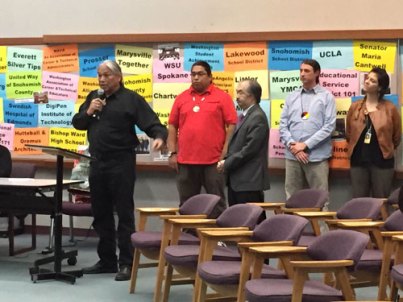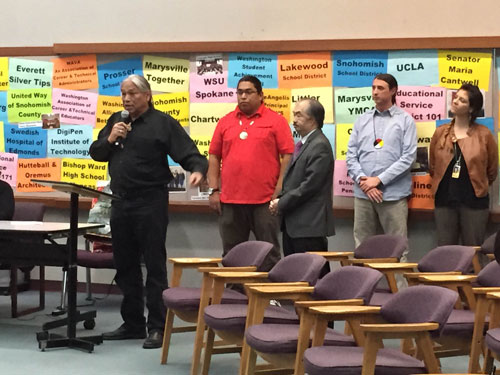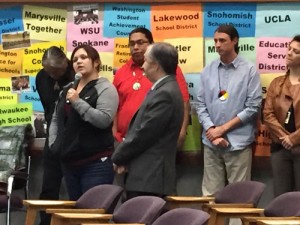By Matt Remle, Indian Country Today Media Network
On October 6, 2014, in a packed Seattle city hall council chambers room, the Seattle city council voted unanimously to rename the second Monday in October, the federal holiday Columbus Day, to Indigenous Peoples’ Day for the city of Seattle. The room erupted in emotion with loud cheers, the sound of drums and the sight of over joyed, smiling and crying faces followed by an impromptu singing of the AIM song in the halls of Seattle city hall.
The Seattle city council vote followed the previous weeks unanimous vote by the Seattle school board to both establish the second Monday in October as a day of observance for Indigenous Peoples’ and to make a board commitment to the teaching of tribal history, culture, governance and current affairs into the Seattle public schools system.
The origins for both the Seattle city council and Seattle school board resolutions date back to 2011, when I was attending an Abolish Columbus Day rally in downtown Seattle. As I was listening to the beautiful songs of a local canoe family, I started thinking about South Dakota and their successful effort to change Columbus Day to Native American Day. That night I decided to contact members of the Seattle city council, as well as, my local State Legislatures to see if they might be willing to do something similar on either the City or State level.
To my surprise, the following morning I got a phone call from Washington State Senator Margarita Prentice and proceeded to have a long conversation about the genocide brought by Columbus to our Native relatives in the Caribbean and how she would love to sponsor a resolution on the State level. She simply asked that I draft a resolution and seek support from area tribes first before she would sponsor the resolution.
Elated, I immediately contacted Theresa Sheldon and Deborah Parker from Tulalip, who were both policy analyst for the Tulalip Tribes at that time, and whom currently sit on the Tulalip Board of Directors, to let them know the news. They agreed to take the resolution to the 2011 Affiliated Tribes of Northwest Indians annual conference and put the Indigenous Peoples’ Day resolution before the conference for a vote. The resolution was unanimously approved, and although the resolution ultimately did not succeed on the State level, the seeds of the Indigenous Peoples’ Day resolution for Seattle were sown.
When Minneapolis approved its Indigenous Peoples’ Day resolution in the early spring of 2014, I figured now might be a good time to revive our efforts in Seattle especially given that we had two new Seattle city council members who had been responsive to the needs and issues of Seattle’s Native community. I again reached out to the Seattle city council members and before the day was over council member Kshama Sawant responded back that she would sponsor an Indigenous Peoples’ Day resolution and asked if I would draft one for her.
I drafted a resolution and sent it out to other members of Seattle’s Native community for additional input. From there a grassroots effort was underway to build broad base support for the resolution. By the time the resolution was presented to the Seattle city council for vote, we gained the endorsement of forty various community organizations, non-profits, human rights organizations, local and national tribal organizations and letters of support from numerous area tribes.
In drafting the resolution, one thought was that we should be pushing for something more than just the renaming of Columbus Day to Indigenous Peoples’ Day, so language was included to have the Seattle city council “encourage” the Seattle public schools to adopt the guidelines established by the 2005 H.B. 1495 and the subsequent Since Time Immemorial Tribal Sovereignty curriculum [STI] that was developed out of it.
Many within the Native community had tried for years to get the Seattle public schools to adopt the STI curriculum, but had always been met with resistance. We figured if we could get the Seattle city council to pass a resolution calling on the school district to adopt the curriculum, we would have good leverage to pressure the school board to adopt it.
Over the summer, a letter was sent to the Seattle school board from the Seattle Human Rights Commission, an early resolution backer, to inform them of the efforts being worked on with the Seattle city council surrounding the Indigenous Peoples’ Day resolution and to encourage them to align efforts with the city to meet the goals of the proposed resolution.
In late July, I was contacted by the Seattle city council and was told that they were ready to put the resolution to the full council for vote. I was given two possible dates to introduce the resolution, one in August and one in September. Since the September date fell on the day before school started in the Seattle area, we went for the September date knowing that we would most likely generate wide-spread media attention and given that Columbus is often one of the things students learn about first, we figured this would be a good strategy to get the evils committed by Columbus on the minds of students.
Up until the September 2, Seattle city council hearing we largely kept the Indigenous Peoples’ Day resolution from the media spotlight. Days before the council meeting we released a press release on the Last Real Indians webpage, whom I am write for. The idea was that we would be asserting our voice on this issue and establish the framework for which the issue would be discussed on our own terms. As the massive rally descended upon the Seattle city council hearing on September 2, the mainstream press was playing a game of catch up on our resolution that had already generated Turtle Island-wide buzz amongst Native communities.
While a decision was made on September 2 to hold the vote off until October 6, we were able to secure the endorsement of Seattle’s Mayor Ed Murray a generated nationwide attention on our Indigenous Peoples’ Day resolution.
Throughout September, we keep up a steady stream of pressure on both the Seattle city council and Seattle school board with emails, petitions, phone calls, and letters of endorsement from area Tribes and other supporters, as well as, built broad support through social media campaigning.
For me personally, it was phenomenal to see such a concerted and collaborative joint effort develop between Seattle’s urban Native community, Tribe’s and Tribal leaders. By time the October 1 Seattle school board vote and the October 6 Seattle city council vote came around a true urban and Tribal partnership was firmly established. The Seattle city council vote saw testimony given from tribal leaders David Bean (Puyallup), Fawn Sharp (President of both the Quinualt Indian Nation and the Affiliated Tribes of Northwest Indians), Mel Sheldon (former Chair of the Tulalip Tribes), as well as, numerous members of Seattle’s urban Native community.
Throughout the whole process, we keep the perspective that we are simply part of a larger movement being fought on the local grassroots level to not only abolish Columbus Day, but see our communities rise up and assert our own voices on our own terms on issues of importance to us.
We sought to show the power our communities possess when we come together unified under the belief and knowledge that what we do today is both work to heal past generations and lift the spirits of our future generations.
Happy Indigenous Peoples’ Day
Mitakuye oyasin.
Matt Remle (Lakota) lives in Seattle. He works for the office of Indian Education in the Marysville/Tulalip school district. He is a writer for Last Real Indians @ www.lastrealindians.com and runs an online Lakota language program at www.LRInspire.com. He is a father of three and the author of Seattle’s Indigenous Peoples’ Day resolution.
Read more at http://indiancountrytodaymedianetwork.com/2014/10/13/rise-indigenous-peoples-day






